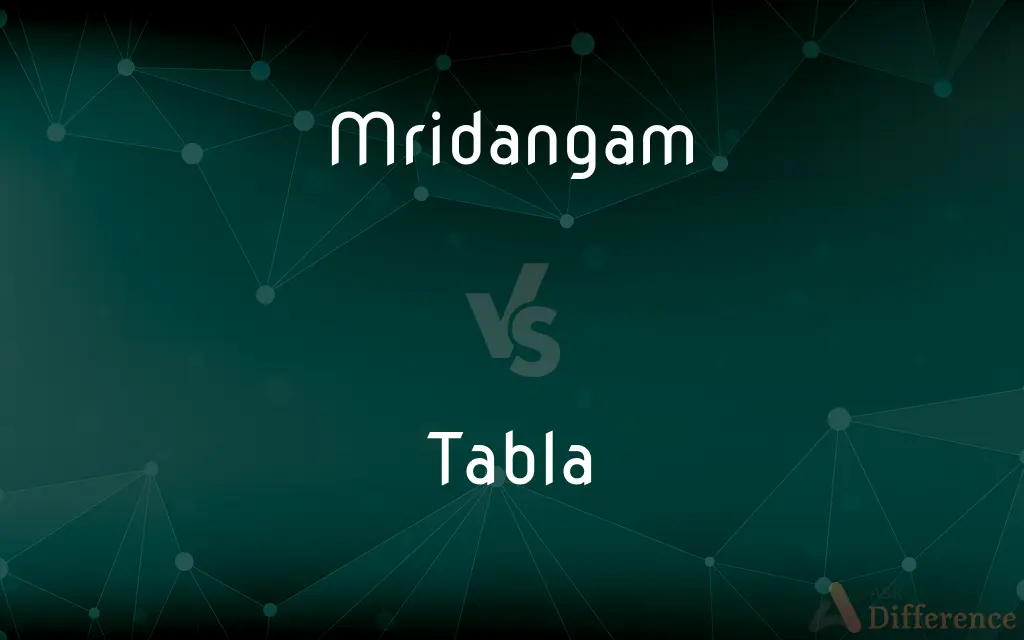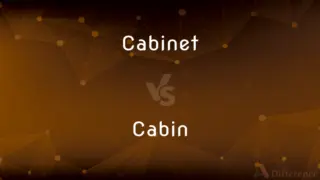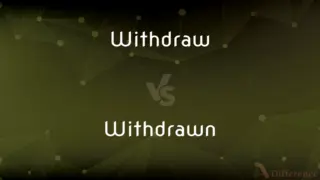Mridangam vs. Tabla — What's the Difference?
Edited by Tayyaba Rehman — By Fiza Rafique — Updated on April 27, 2024
Mridangam is a double-sided drum integral to South Indian classical music, characterized by its elongated barrel shape, whereas the tabla, prominent in North Indian music, consists of a pair of smaller, distinct drums.

Difference Between Mridangam and Tabla
Table of Contents
ADVERTISEMENT
Key Differences
The mridangam is a percussion instrument used primarily in Carnatic music of South India, featuring a body made from jackwood and two distinct playing surfaces. In contrast, the tabla is used in Hindustani music from North India and includes two separate drums, the dayan and the bayan, made from different materials like wood and metal.
Mridangam players use their palms and fingers to strike the drumheads, which are layered with a mixture of rice paste and stone powder to create a rich, resonant sound. On the other hand, tabla players often use a complex finger technique involving rhythmic patterns and resonances tuned specifically by applying a mixture of water and flour to the smaller drum, the dayan.
Tuning the mridangam involves adjusting leather straps around the drum, impacting both sides simultaneously to maintain a balance in pitch and tone. The tabla, however, is tuned by striking the rim of the drumhead with a small hammer, allowing for fine adjustments to each drum independently.
Historically, the mridangam has roots in ancient South Indian traditions and is featured in religious and ceremonial music, reflecting its cultural significance. The tabla originates from North Indian classical and folk traditions, gaining prominence in both solo and ensemble performances in a variety of musical styles.
The mridangam is usually played as a solo or as a complement to vocal and instrumental Carnatic performances, emphasizing rhythmic patterns and cycles. The tabla, meanwhile, is versatile in accompanying dance, vocal, and instrumental music, capable of intricate rhythmic improvisations and interactions with other musicians.
ADVERTISEMENT
Comparison Chart
Origin
South Indian Carnatic music
North Indian Hindustani music
Composition
Single drum, double-sided
Pair of drums, dayan and bayan
Material
Mainly jackwood
Combination of wood and metal
Tuning Mechanism
Leather straps adjusted manually
Rim struck with hammer for tuning
Typical Use
Solo and accompaniment in Carnatic
Versatile in solo and ensemble
Compare with Definitions
Mridangam
Features a barrel-shaped wooden body.
The deep tones of the mridangam's wooden body resonated through the auditorium.
Tabla
Consists of the dayan and the bayan.
He tuned the dayan carefully, ensuring it harmonized with the bayan.
Mridangam
Percussion instrument used in Carnatic music.
The mridangam player performed an intricate solo during the concert.
Tabla
Characterized by its clear, tuneful sound.
The tabla's melodious beats were a highlight of the evening.
Mridangam
Played using palms and fingers.
He expertly manipulated the mridangam's surface with rapid finger movements.
Tabla
A pair of drums used in Hindustani music.
The tabla player accompanied the sitarist with rhythmic precision.
Mridangam
Integral to religious and ceremonial music in South India.
At the temple festival, the mridangam accompanied the priest's chants.
Tabla
Requires intricate finger techniques.
Her tabla playing was marked by complex rhythmic cycles executed flawlessly.
Mridangam
Known for its deep, resonant sound.
The mridangam's sound added a profound depth to the performance.
Tabla
Widely used in both classical and popular music forms.
The concert featured a tabla solo that captivated the audience.
Mridangam
The mridangam is a percussion instrument of ancient origin. It is the primary rhythmic accompaniment in a Carnatic music ensemble, and in Dhrupad, where a modified version, pakhawaj is the primary percussion intrument.
Tabla
A tabla is a pair of twin hand drums from the Indian subcontinent. Since the 18th century, tabla has been the principal percussion instrument in Hindustani classical music, where it may be played solo, as accompaniment with other instrument and vocals, and as a part of larger ensembles.
Mridangam
(musical instruments) A percussion instrument used in southern Indian music, consisting of a two-sided drum whose body is usually made from a hollowed piece of jackfruit wood.
Tabla
A small hand drum of northern India.
Tabla
A pair of drums, differing in size and tone, played together.
Tabla
(musical instruments) A pair of tuned hand drums, used in various musical genres of the Indian subcontinent, that are similar to bongos.
Common Curiosities
Which regions are the mridangam and tabla predominantly used in?
The mridangam is predominantly used in South India, especially in Carnatic music, while the tabla is used throughout North India in Hindustani music.
What type of music are the mridangam and tabla most commonly associated with?
The mridangam is closely associated with Carnatic music of South India, while the tabla is integral to Hindustani classical music from North India.
What materials are used to make the mridangam and tabla?
The mridangam is typically made from jackwood, while the tabla's dayan is usually made from various kinds of wood and the bayan from metal or clay.
Are there specific playing techniques unique to the mridangam and tabla?
Yes, the mridangam is played using a combination of palm and finger strokes, while tabla playing involves detailed finger and hand techniques, including the use of the heel of the hand.
What is the main difference in the construction of the mridangam and tabla?
The mridangam is a single, double-sided drum, while the tabla consists of two separate drums, each tuned differently.
How are the mridangam and tabla tuned?
The mridangam is tuned by adjusting leather straps, affecting both drumheads, whereas the tabla is tuned by striking the rim with a hammer, allowing for individual tuning of each drum.
What roles do the mridangam and tabla play in an ensemble?
In Carnatic music, the mridangam often accompanies the main performer, providing rhythmic support and interacting with the melodic line. The tabla plays a similar role in Hindustani music, but it also features prominently in solo performances.
What is the cultural significance of the mridangam and tabla in their respective music genres?
Both instruments hold significant cultural importance; the mridangam is revered in South Indian culture, often played in religious and ceremonial settings, while the tabla is celebrated in North Indian culture for its versatility in classical, folk, and popular music genres.
How do the sounds of the mridangam and tabla differ?
The mridangam produces a deep, resonant sound that is rich in overtones, whereas the tabla offers a sharper, clearer sound that can range from deep tones from the bayan to the high-pitched dayan.
How are the drumheads of the mridangam and tabla prepared?
Both instruments' drumheads are treated with a mixture to enhance the quality of the sound; the mridangam uses a paste made of rice and stone, while the tabla uses a mixture called "shyahi" made of flour and iron filings.
How do performers learn the mridangam and tabla?
Learning both instruments usually involves years of study under a master, with a focus on complex rhythmic patterns and improvisation techniques specific to each musical tradition.
Are there any famous musicians known for playing the mridangam and tabla?
Yes, Umayalpuram K. Sivaraman and T. V. Gopalakrishnan are renowned mridangam players, while Zakir Hussain and Alla Rakha are legendary tabla maestros.
Can the mridangam and tabla be learned and played by musicians from other musical traditions?
Yes, both instruments are studied and played globally, though learning them typically involves deep immersion in their respective musical traditions due to their complex rhythmic structures.
Share Your Discovery

Previous Comparison
Cabinet vs. Cabin
Next Comparison
Withdraw vs. WithdrawnAuthor Spotlight
Written by
Fiza RafiqueFiza Rafique is a skilled content writer at AskDifference.com, where she meticulously refines and enhances written pieces. Drawing from her vast editorial expertise, Fiza ensures clarity, accuracy, and precision in every article. Passionate about language, she continually seeks to elevate the quality of content for readers worldwide.
Edited by
Tayyaba RehmanTayyaba Rehman is a distinguished writer, currently serving as a primary contributor to askdifference.com. As a researcher in semantics and etymology, Tayyaba's passion for the complexity of languages and their distinctions has found a perfect home on the platform. Tayyaba delves into the intricacies of language, distinguishing between commonly confused words and phrases, thereby providing clarity for readers worldwide.
















































